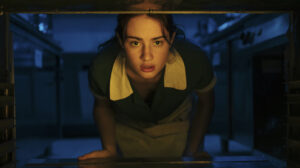Sundance Interview with Sam Levy, Cinematographer of “Mayday”
Written by: Hannah Tran | February 4th, 2021
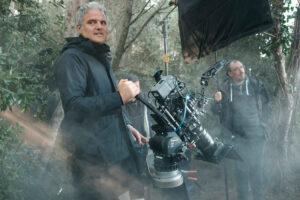
Frances Ha, Mistress America, Lady Bird and Wendy and Lucy … of course, I am referring to the work of some of our greatest living directors: Noah Baumbach, Greta Gerwig, and Kelly Reichardt. More specifically, I am referring to the wonderful characters at the center of them, women whose everyday struggles are met with determination, charm, confusion, humor and creativity. These are women who were seminal to my upbringing, far beyond film. This last week, I had the pleasure to speak to one of the people responsible for bringing them to the screen, cinematographer Sam Levy.
In his latest work, the Sundance-premiered Mayday, Levy trades New York streets for a fantasy realm of forests and beaches, creating a lush world that is completely its own. It is both familiar and fantastical in its unique presentation of an array of characters not unlike those mentioned earlier. Based around the myth of the sirens, Mayday follows a young woman named Ana (Grace Van Patten, Good Posture) after she steps through a portal into another world and finds herself among a group of female soldiers in the midst of an endless war. It was my distinct privilege to get a glimpse into that world within this conversation. Below is a transcript of our interview, edited for clarity.

Hannah Tran: So, Mayday sounds pretty removed from your previous work. I was wondering if your approach for this one was, in fact, different or if there were any new challenges it presented?
Sam Levy: It’s extremely different. It’s an action-adventure about a young woman finding her voice, and it’s kind of a modern take on The Wizard of Oz. There’s a lot of action sequences, motorcycles, hand-to hand-combat, and explosions. I’ve done all of that here and there, particularly on commercials, but, you know, there are no explosions or fight sequences in Frances Ha.
HT: Well, there’s play fighting in Frances Ha.
SL: That’s right! That’s the very first shot of the movie. And it does have a lot in common with those films in terms of its visual screenplay and dialogue, but breaking the material down and trying to reconstitute it in a cinematic way felt different. There were many technical things I was doing for the first time. It was also actually my first time being one of the producers for a feature. But it’s nice to try things you haven’t before and go a little out of your depth because you can work in a really interesting area when your feet aren’t totally touching the bottom of the ocean.
HT: And because Mayday is quite different narratively than most of your other work, I was curious to know if there were any specific movies or other forms of art that you were pulling from to establish the look of the film.
SL: Definitely. At the same time, though, I’m always careful to not over-reference things. It’s hard because there are so many films I love and am inspired by. But on Mayday, I tried to not be too referential because it’s a script that I think is really innovative, and I wanted it to have its own voice. With that said, a film we looked at a lot was Elem Klimov’s Come and See, which is interesting because it’s kind of a morose drama that also has action elements that any war movie might. It’s beautiful, and it has a very muted color palette. We also looked at Powell and Pressburger’s The Red Shoes and Black Narcissus. More recently, we looked at the Taiwanese director Tsai Ming-liang’s films, like Rebels of the Neon God and The River.
We also looked at the Japanese photographer Rinko Kawauchi’s book, Halo. There are a lot of abstract images within that of reflections in water and bubbles in the deep sea, and there are some beautiful colors. It’s printed on this really tactile matte paper. We would just look at the book and feel how it felt in our hands. It wasn’t just the images that spoke to us but the way we took them in on this paper. We wanted the image to look the way that piece of paper feels. So, some of these are direct in terms of the technical aspects of the film, and some are more subtle, like the way you feel when you look at these things and the way you take them in.
HT: Mayday is a story of wartime, and you’re working with this cast of actors who are all so beautiful in a way atypical of this sort of setting. Did you have a conversation about how you wanted to frame them and make them look on screen?
SL: Definitely. What’s interesting about working with Karen is that she’s not only my longtime collaborator, she’s also my life partner. A great way to start a conversation with a director if you’re a cinematographer is to start by looking at photos or paintings or other visual tools just to spark the conversation. Mayday is a story about young women fighting in an army and finding their voice, and so we looked for images that spoke to this. It sounds bad for me to say it, but when you’re looking at most fashion or art photos throughout history, it’s incredibly difficult to find images of young women who aren’t depicted as being passive. Usually, they’re lying on the couch or the ground or in water. There aren’t many images of women soldiers or women who are actively engaged. I even went to my favorite photobook store in New York, Dashwood, and I have a couple of friends who are women who work there, and they verified this. It’s not that you can’t find them. They exist, but they’re very rare.
But yes, these are women who are not passive and who are self-possessed, and that’s how they needed to be seen. We wanted them to look great in a way that suits their character, and luckily, the actors were so deep into their character work that they weren’t concerned with being vain. Through the process of doing hair and makeup tests with our team, we grew to trust each other. And I think they could sense that Karen and I are partners, and we wanted to present them in this dynamic way that stood in contrast to art history.
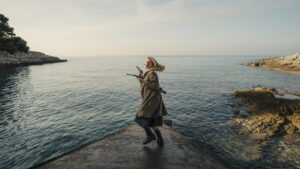
HT: And continuing on the subject of the cast, I know you’ve said you’re very interested in the blocking of the actors within a scene. And I know Greta, for example, says that she treats her script like it’s bible. I was wondering how much you allow for experimentation by the actors while shooting?
SL: A lot. We always try to make a specific plan with the director ahead of time, and that helps for rehearsal. Working with Greta and even Kelly Reichardt to a certain extent, their first instinct was to do a rehearsal with the actors and see what they did first and use that as a framework to shift what they didn’t like. When I worked with Noah Baumbach, he would usually make a few suggestions before the first blocking and then shape it from there. With Karen, a lot of what we did was very intricate because of the action and stunt sequences. We would storyboard a little and work with the stunt team, but we had to be more specific for safety reasons. You can only experiment so much if there’s going to be an explosion nearby. For the more intimate scenes, though, we’d usually just give them some basics, like the parameters of the frame, and see what they’d try. Usually, they’d have some thought about where to move or what to do.
HT: You’ve worked with a lot of major women directors, and often they’re making very women-centered narratives. I was wondering if you think this is merely happenstance or if you feel there is something that draws you to their work or something about your work that they feel is specifically compatible with their own?
SL: That’s a great question, and I really don’t know. Sometimes I wonder. You know, my father was a violinist in the Boston Symphony.
HT: Oh wow! My parents were also professional violinists.
SL: Oh really? Where did they play?
HT: They both played in the San Diego Symphony. That’s a funny connection.
SL: Yeah, really. Well, my dad played in the Boston Symphony and the Boston Pops, and my mom is an attorney, but she’s a very, very talented amateur flutist. When I grew up, my dad worked, but my mom worked longer hours. My dad did most of the cooking, and my mom was a real career-oriented woman, and she often told me she felt guilty about it. I was born in her first year of law school. I don’t know if this directly correlates, but I think that may have shaped my worldview a little. And, of course, my life partner is a writer and director.
But yes, I’ve worked for more women than I have men. Do I actively seek that? No. The truth is I don’t, but I love it. Most people who’ve been working as long as I have can’t say the same. For example, about five or six years ago when I shot Rebecca Miller’s movie, Maggie’s Plan, with Greta Gerwig and Ethan Hawke, Ethan Hawke said he’d never been in a movie directed by a woman before. Now, he’d been in, I don’t know, maybe 40 or 50 movies? I was shocked. As a DP, though, you can only shape your career with the directors you work with so much. If there’s someone whose work you admire, you can certainly try to reach out to them, but there’s no telling if they’ll hire you. So, I can’t take too much credit, but I do feel very fortunate.
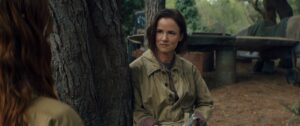
HT: And is there any way you feel that your dad being a violinist shaped your worldview?
SL: Well, we’re uniquely qualified to have this conversation, Hannah. I don’t know what it was like for you, but it’s very intense to grow up in a house with a classical musician. My dad practiced, like, seven hours a day in addition to rehearsals. They play four or five bars over and over, and it’s the worst. When I tell people my story, they’re like “Oh, that must’ve been so great,” and it was, but it’s so intense. It’s not like going to Symphony Hall. But as I get older, having that exposure to my dad practicing so insanely, I think it had a good effect on my work ethic. And nobody in my family worked in film, but the first time I set foot on a film set, it felt like being backstage at Symphony Hall. There, you learn these classical musicians backstage are not elegant like they are onstage. They’re playing cards and smoking cigars. I love all those men and women, and being on set felt so similar. It felt like home. The chaos of a film set felt like the chaos of backstage.
HT: Now, you also apprenticed for Harris Savides, and you were taught by Eric Rohmer. These are two of my personal favorites. Could you share some of the important lessons you feel you took from them?
SL: Yeah, so I was a comparative literature major at Brown. There, you’re asked to pick a foreign language to study literature in, and I chose French. In my junior year, I got to study literature at the Sorbonne in Paris. And there, I found out about a class that Rohmer taught at a university across the Sorbonne. It was really more of a film theory class. We mainly just watched and discussed films. Even though he was a writer and director, the class had a special emphasis on cinematography. He spoke on his own experience with the image and working with cinematographers like Néstor Almendros. It was great. He would show movies with no sound, mostly his own, and discuss them almost like the director’s commentary on a Criterion movie except it was in person.
What’s interesting about Rohmer’s work is that there’s a lot of dialogue, but they handle the dialogue in a really interesting way. There aren’t two or three cameras. He would only work with one. He was severely ecologically minded before that became ubiquitous. He never owned a telephone. He was a jogger. He was into yoga before a lot of people even knew what that was. And very famously, he would only do one take, and if they didn’t quite get it or made a mistake, he would move on. A lot of that was about film being a physical material that, although beautiful, is not good for the earth. So learning about the discipline of his approach was very interesting.
Then, I met Harris when I was a camera assistant for a commercial. Eventually, he was looking for someone like me to take notes for him and do lighting diagrams. And so, we did this movie, The Yards, which was directed by James Gray. I never properly went to film school, but getting to do that with Harris felt like my film school. I took set photos, photoshopped them, and made sure the dailies looked exactly the way he intended. That’s when I learned about the print light system and the photochemical lab. Learning theory with Rohmer and filmmaking with Harris was a great combination. And later, Harris did two movies with Noah Baumbach, and Noah asked Harris to do Frances Ha, and he had the rough idea to shoot digitally. Harris couldn’t do it, but he believed in my abilities for digital imaging because I had taken a lot of digital stills for him, and I became good at manipulating them and controlling the integrity of the final image. Plus, he knew I had studied with Rohmer, and Noah is probably the worlds’ biggest Rohmer fan. His first child, even, is named after Rohmer. Harris knew exactly how to introduce me. He was like, “You have to meet Sam, he studied with Rohmer.” That’s really all he had to say.
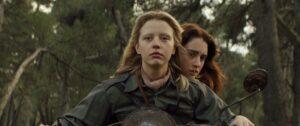
HT: Alright, so my last question doesn’t have to be on the record, but I just wanted to ask about something I was curious about. I wanted to know how you got that one shot in Frances Ha of Sophie’s glasses in the cab?
SL: I love that question. I’m happy to be on the record. The actor who played Sophie, Mickey Sumner, found those glasses. They were made with this silver, metallic finish that just reflected light in this really specific, glinty way. So it’s two things: the glasses, and we were using this really, really small paper lantern above the camera. And, you know, I was always trying to get the actors in front of a lens to test their hair, their makeup, their wardrobe, the locations, or whatever before just to see what we had, and I definitely noticed the effect of the glasses. So there’s no secret. I can’t say, “Go to Warby Parker, get no. 3.” It was that the light from this paper lantern was barely turned on, and it’s a really dark scene shot in black and white so the contrast is particularly accentuated.
It’s funny. I think it was on the Manhattan Bridge, and we just hailed a yellow cab. It was that kind of movie. We just asked, “How much would it cost to hire you for an hour to go back and forth across this bridge?” That night, I think it was just the two actors, Noah, and myself. We really tried to stay small and sparse in terms of crew, and it was the two of them populating the back seat and the cab driver in front. It was the last thing we had to do for the night, and I think we did one run before I just showed Noah the playback, and he was just like, “That’s great. Here’s a couple of notes. I’m going home, and I’ll see you tomorrow.” So we did it maybe ten times, and he used those ten seconds.
HT: I loved that shot. So happy you could answer my question!
SL: Thank you so much for talking. I wish they were all this pleasant.
HT: No, thank you! This was a lot of fun. Hope you have a great Sundance.
